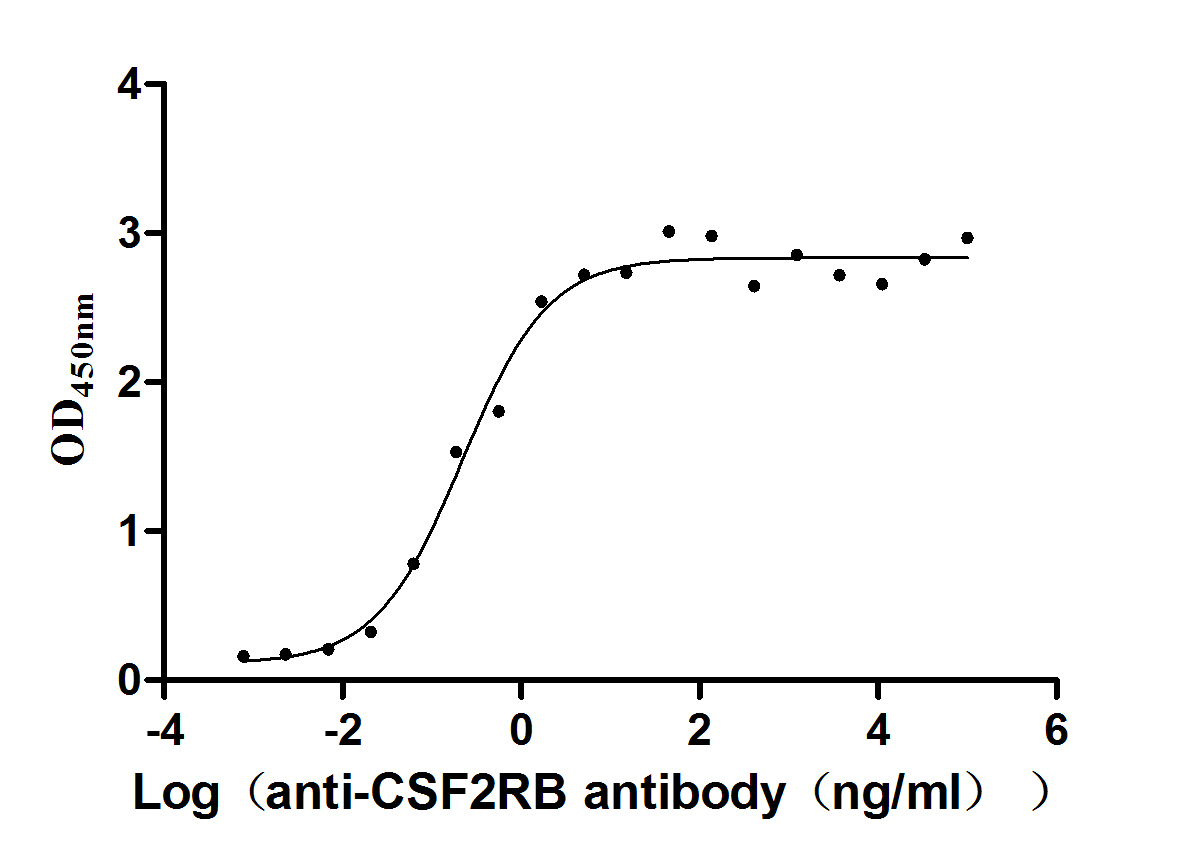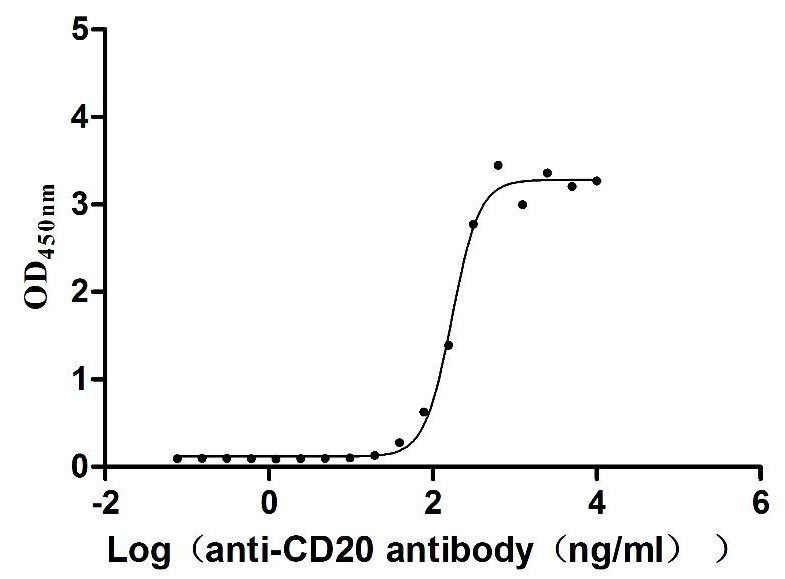Recombinant Human Proteasomal ubiquitin receptor ADRM1 (ADRM1)
-
货号:CSB-YP614959HU
-
规格:
-
来源:Yeast
-
其他:
-
货号:CSB-EP614959HU-B
-
规格:
-
来源:E.coli
-
共轭:Avi-tag Biotinylated
E. coli biotin ligase (BirA) is highly specific in covalently attaching biotin to the 15 amino acid AviTag peptide. This recombinant protein was biotinylated in vivo by AviTag-BirA technology, which method is BriA catalyzes amide linkage between the biotin and the specific lysine of the AviTag.
-
其他:
-
货号:CSB-BP614959HU
-
规格:
-
来源:Baculovirus
-
其他:
-
货号:CSB-MP614959HU
-
规格:
-
来源:Mammalian cell
-
其他:
产品详情
-
纯度:>85% (SDS-PAGE)
-
基因名:ADRM1
-
Uniprot No.:
-
别名:110 kDa cell membrane glycoprotein; adhesion regulating molecule 1; Adhesion-regulating molecule 1; ADRM 1; Adrm1; ADRM1_HUMAN; ARM 1; ARM-1; ARM1; Gp110; hRpn13; M(r) 110,000 surface antigen; Proteasomal ubiquitin receptor ADRM1; proteasome regulatory particle non ATPase 13; Proteasome regulatory particle non-ATPase 13; Regulatory particle non ATPase 13; Rpn13; Rpn13 homolog
-
种属:Homo sapiens (Human)
-
蛋白长度:Full Length of Mature Protein
-
表达区域:2-407
-
氨基酸序列TTSGALFPS LVPGSRGASN KYLVEFRAGK MSLKGTTVTP DKRKGLVYIQ QTDDSLIHFC WKDRTSGNVE DDLIIFPDDC EFKRVPQCPS GRVYVLKFKA GSKRLFFWMQ EPKTDQDEEH CRKVNEYLNN PPMPGALGAS GSSGHELSAL GGEGGLQSLL GNMSHSQLMQ LIGPAGLGGL GGLGALTGPG LASLLGSSGP PGSSSSSSSR SQSAAVTPSS TTSSTRATPA PSAPAAASAT SPSPAPSSGN GASTAASPTQ PIQLSDLQSI LATMNVPAGP AGGQQVDLAS VLTPEIMAPI LANADVQERL LPYLPSGESL PQTADEIQNT LTSPQFQQAL GMFSAALASG QLGPLMCQFG LPAEAVEAAN KGDVEAFAKA MQNNAKPEQK EGDTKDKKDE EEDMSLD
-
蛋白标签:Tag type will be determined during the manufacturing process.
The tag type will be determined during production process. If you have specified tag type, please tell us and we will develop the specified tag preferentially. -
产品提供形式:Lyophilized powder
Note: We will preferentially ship the format that we have in stock, however, if you have any special requirement for the format, please remark your requirement when placing the order, we will prepare according to your demand. -
复溶:We recommend that this vial be briefly centrifuged prior to opening to bring the contents to the bottom. Please reconstitute protein in deionized sterile water to a concentration of 0.1-1.0 mg/mL.We recommend to add 5-50% of glycerol (final concentration) and aliquot for long-term storage at -20℃/-80℃. Our default final concentration of glycerol is 50%. Customers could use it as reference.
-
储存条件:Store at -20°C/-80°C upon receipt, aliquoting is necessary for mutiple use. Avoid repeated freeze-thaw cycles.
-
保质期:The shelf life is related to many factors, storage state, buffer ingredients, storage temperature and the stability of the protein itself.
Generally, the shelf life of liquid form is 6 months at -20°C/-80°C. The shelf life of lyophilized form is 12 months at -20°C/-80°C. -
货期:Delivery time may differ from different purchasing way or location, please kindly consult your local distributors for specific delivery time.Note: All of our proteins are default shipped with normal blue ice packs, if you request to ship with dry ice, please communicate with us in advance and extra fees will be charged.
-
注意事项:Repeated freezing and thawing is not recommended. Store working aliquots at 4°C for up to one week.
-
Datasheet :Please contact us to get it.
相关产品
靶点详情
-
功能:Component of the 26S proteasome, a multiprotein complex involved in the ATP-dependent degradation of ubiquitinated proteins. This complex plays a key role in the maintenance of protein homeostasis by removing misfolded or damaged proteins, which could impair cellular functions, and by removing proteins whose functions are no longer required. Therefore, the proteasome participates in numerous cellular processes, including cell cycle progression, apoptosis, or DNA damage repair. Within the complex, functions as a proteasomal ubiquitin receptor. Engages and activates 19S-associated deubiquitinases UCHL5 and PSMD14 during protein degradation. UCHL5 reversibly associate with the 19S regulatory particle whereas PSMD14 is an intrinsic subunit of the proteasome lid subcomplex.
-
基因功能参考文献:
- Rpn13-Rpn2 complex structural analysis shows that RA190 targets hRpn13 and Uch37 through parallel mechanisms and at proteasomes, RA190-inactivated Uch37 cannot disassemble hRpn13-bound ubiquitin chains PMID: 28598414
- findings indicate that up-regulated ADRM1 was involved in intrahepatic cholangiocarcinoma (ICC) progression and suggest the potential clinical application of ADRM1 inhibitors (e.g., RA190 and KDT-11) for ICC treatment. PMID: 29913454
- We show that ADRM1 mRNA overexpression is an early event in high grade serous carcinoma of the ovary. This is associated with TP53 mutation and increased burden of misfolded proteins in carcinomas that likely renders the cancer cells particularly sensitive to RPN13 inhibitors. PMID: 28784174
- evidence that the interaction can mediate the association of Rpn13 and SGTA in a cellular context. PMID: 27827410
- The structures of proteasome substrate receptor complexes with the shuttle factors that deliver ubiquitinated proteins to proteasomes have been solved, namely human Rpn13 complexed with PLIC2 and Saccharomyces cerevisiae Rpn1 with Rad23. PMID: 27396824
- RPN13 binds ubiquitin with an affinity similar to that of other proteasome-associated ubiquitin receptors and that RPN2, ubiquitin, and the deubiquitylase UCH37 bind to RPN13 with independent energetics. PMID: 28442575
- regulation of NY-ESO-1 processing by the ubiquitin receptors Rpn10 and Rpn13 as a well as by the standard and immunoproteasome is governed by non-canonical ubiquitination on non-lysine sites. PMID: 26903513
- this work implicates hRpn13 and Uch37 in cell cycle progression, providing a rationale for their function in cellular proliferation and for the apoptotic effect of the hRpn13-targeting molecule RA190. PMID: 26907685
- the binding of SGTA to Rpn13 enables specific polypeptides to escape proteasomal degradation and/or selectively modulates substrate degradation. PMID: 26169395
- Data suggest that ADRM1 is involved in proliferation of acute leukemia cells; expression of ADRM1 is up-regulated in leukemia; knockdown of ADRM1 inhibits cell proliferation at G0/G1 phase of cell cycle but does not affect apoptosis/cell migration. PMID: 25896055
- findings implicate Rpn13 in linking parkin to the 26 S proteasome and regulating the clearance of mitochondrial proteins during mitophagy PMID: 25666615
- Data show that DEUBAD domain in RPN13 (ADRM1) activates ubiquitin thioesterase L5 (UCH-L5), and the related DEUBAD domain in INO80G (NFRKB) inhibits UCH-L5. PMID: 25702870
- Together, our findings suggest that the interaction of Psmd1 with Adrm1 is controlled by SUMOylation in a manner that may alter proteasome composition and function. PMID: 24910440
- ADRM1 is a candidate target gene in the chromosome 20q13.33 amplicon that may possibly be linked to development of gastric cancer PMID: 24968865
- Autoubiquitination of the 26S proteasome on Rpn13 regulates breakdown of ubiquitin conjugates. PMID: 24811749
- Inherent asymmetry in the 26S proteasome is defined by the ubiquitin receptor RPN13. PMID: 24429290
- mRNA and protein levels of ADRM1 were increased in hepatocellular carcinoma tissues and was parallel to the metastatic potential PMID: 22576803
- hRpn13 modulates the influence of osteoblasts on osteoclasts by controlling the stability of regulatory proteins in osteoblasts. PMID: 22057889
- this study provides a possible mechanism of action in ovarian cancer for amplification and overexpression of ADRM1 PMID: 21432940
- In tumor cells non-phosphorylated DeltaNp63alpha failed to form protein complexes with Rpn13, allowing the latter to bind and target LKB1 into a proteasome-dependent degradation pathway, modulating cisplatin-induced autophagy. PMID: 21191146
- Phosphorylated TP63 induces transcription of RPN13, leading to NOS2 protein degradation PMID: 20959455
- Silencing of Adrm1 by RNA interference can significantly suppress proliferation of colorectal cancer cells through inducing apoptosis and arresting the cell cycle. PMID: 20137344
- show that Rpn13 is involved in inducible nitric oxide synthase degradation and is required for iNOS interaction with the deubiquitination protein UCH37. PMID: 20634424
- results suggest that there is different substrate specificity between S5a and hRpn13 at the level of delivery and S5a may be the major docking site for ERAD substrates. PMID: 20417181
- Rpn13 binding to the proteasome scaffolding protein hRpn2/S1 abrogates its interdomain interactions, thus activating hRpn13 for ubiquitin binding. PMID: 20471946
- ARM-1 is a cytosolic protein associated with the plasma membrane. However, no cell surface expression of the protein was observed. These results suggest an indirect role of ARM-1 in adhesion rather than a direct role as an adhesion molecule itself.[ARM-1] PMID: 15819879
- Adrm1 has a specialised role in proteasome function. Identified Adrm1 as a novel component of the regulatory ATPase complex of the 26 S proteasome PMID: 16815440
- Neither Uch37 alone nor the Uch37-Adrm1 or Uch37-Adrm1-S1 complexes can hydrolyse di-ubiquitin efficiently; rather, incorporation into the 19S complex is required to enable processing of polyubiquitin chains. PMID: 16906146
- These results indicate that hRpn13 (Adrm1) is essential for the activity of UCH37. PMID: 16990800
- In human 26S proteasomes, hRpn13 appears to be important for the binding of UCH37 to the 19S complex and for efficient proteolysis. PMID: 17139257
- identification of a new ubiquitin receptor, Rpn13/ARM1, a known component of the proteasome PMID: 18497817
- ADRM1 overexpression was the most highly correlated with amplification and is associated with ovarian cancer. PMID: 18615678
- Adrm1 is potentially oncogenic and may play an important role in colon tumorigenesis PMID: 19148532
- these data suggest that Adrm1, a new Atp6v0d2-interacting protein, plays an important role in osteoclast differentiation, and in particular the fusion of preosteoclasts. PMID: 19818731
显示更多
收起更多
-
亚细胞定位:Cytoplasm. Nucleus.
-
蛋白家族:ADRM1 family
-
数据库链接:
HGNC: 15759
OMIM: 610650
KEGG: hsa:11047
STRING: 9606.ENSP00000253003
UniGene: Hs.90107
Most popular with customers
-
Recombinant Human Cytokine receptor common subunit beta (CSF2RB), partial (Active)
Express system: Mammalian cell
Species: Homo sapiens (Human)
-
Recombinant Macaca mulatta Semaphorin-4D isoform 1 (SEMA4D), partial (Active)
Express system: Mammalian cell
Species: Macaca mulatta (Rhesus macaque)
-
Recombinant Dog B-lymphocyte antigen CD20 (MS4A1)-VLPs (Active)
Express system: Mammalian cell
Species: Canis lupus familiaris (Dog) (Canis familiaris)
-
Recombinant Mouse Complement component C1q receptor (Cd93), partial (Active)
Express system: Mammalian cell
Species: Mus musculus (Mouse)
-
Recombinant Human Carcinoembryonic antigen-related cell adhesion molecule 8(CEACAM8) (Active)
Express system: Mammalian cell
Species: Homo sapiens (Human)
-
-
Recombinant Human Interleukin-1 receptor accessory protein (IL1RAP), partial (Active)
Express system: Mammalian cell
Species: Homo sapiens (Human)
-
Recombinant Macaca fascicularis Interleukin 1 receptor accessory protein(IL1RAP), partial (Active)
Express system: Mammalian cell
Species: Macaca fascicularis (Crab-eating macaque) (Cynomolgus monkey)




















